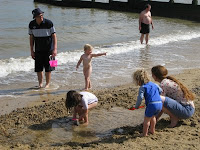Donna and I headed for Snape Maltings again to visit the shops while the rest of the family headed to Framlingham Castle. After lunch we met up in Southwold for an afternoon at the beach.
 Snape Maltings, where we went for last night's concert, is also home to some very nice shops selling food, books, antiques, toys, garden plants, gifts and more. We drove over mid-morning and explored, then visited the cafe and sat outside until driven back indoors by wasps!
Snape Maltings, where we went for last night's concert, is also home to some very nice shops selling food, books, antiques, toys, garden plants, gifts and more. We drove over mid-morning and explored, then visited the cafe and sat outside until driven back indoors by wasps!After lunch we continued to Southwold and met up on the beach beside the pier. The afternoon weather was warm and sunny and we had a lot of fun digging a pond in the sand, splashing in the water, and generally doing seaside things.

It was lovely to watch the four grandchildren enjoying themselves. For Sara and little Verity it was an opportunity to explore an unusual environment. Isn't it astonishing how children take non-routine experiences and circumstances in their stride? They quickly work out how to make the most of what's on offer - in this case sand, pebbles, surging waves, and running in and out of the shallow water.
After that it was back to 'Curlew House' where we're staying, Paz and Donna cooked up pasta and salad for tea and Paz produced two magnificent plum crumbles made with 'Victoria' plums from the tree in their garden at home.
Beth and Donna had tickets for another performance at Snape, 'Jazz Jamaica'. They headed off for the music after the meal and the rest of us chatted, read or watched TV after the children were all tucked up in bed.
< Schubert's 10th | Index | Thorpeness walk >


